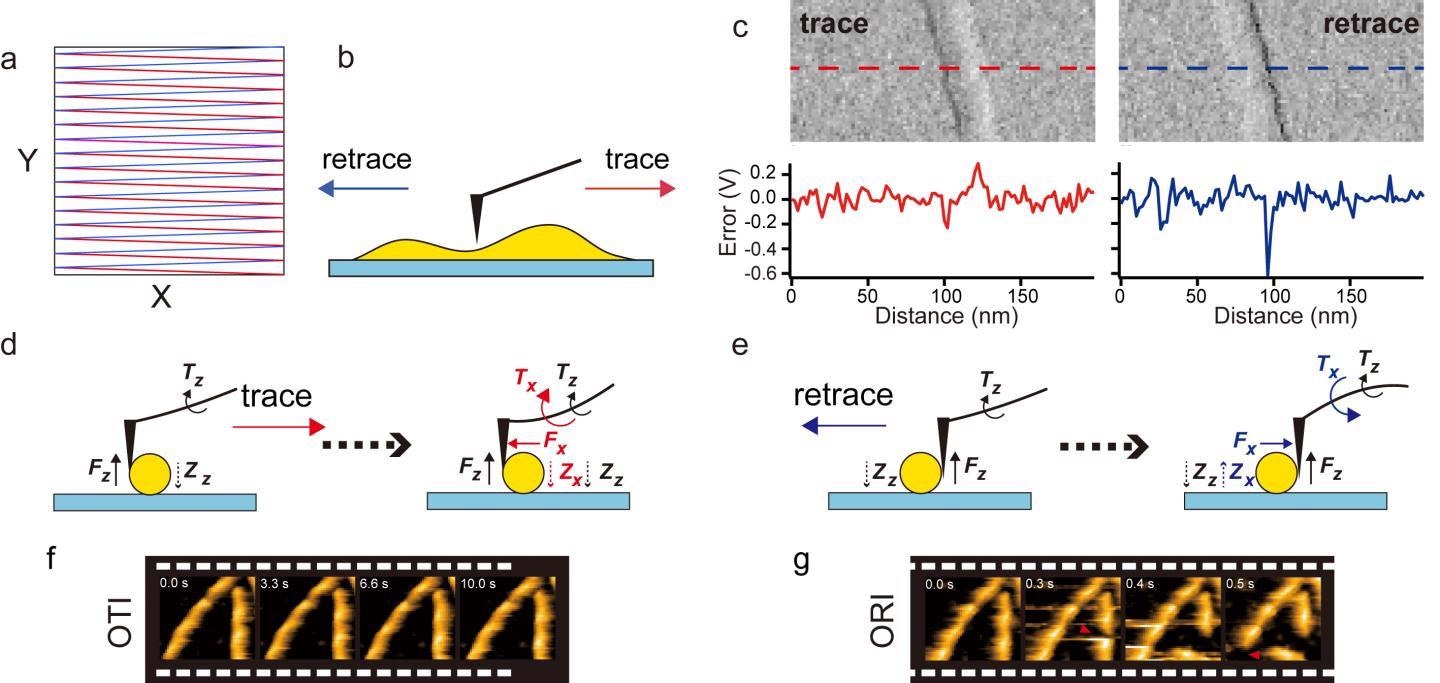Mar 30 2021
High speed atomic force microscopy (HS-AFM) is defined as an imaging method that can be employed for imaging biological processes, for instance, the activity of proteins. Current standard HS-AFM frame rates are as high as 12 frames per second (fps).
 (a) Raster scanning: Trace scanning (red line) and retrace scanning (blue line) of the sample stage, (b) directions of tip scanning relative to sample in trace and retrace scanning processes, (c) difference in feedback control error between the trace and retrace scanning processes. Error images of the actin filament oriented nearly along the Y-axis (top) and the error profile (bottom), (d, e) difference in the directions of torques produced by lateral and vertical forces exerted on the cantilever from the sample during trace (d) and retrace (e) scanning processes, (f, g) HS-AFM images of actin filaments captured at 10 fps in the OTI (f) and ORI (g) modes. In the ORI mode, actin filaments were quickly broken. Image Credit: Kanazawa University.
(a) Raster scanning: Trace scanning (red line) and retrace scanning (blue line) of the sample stage, (b) directions of tip scanning relative to sample in trace and retrace scanning processes, (c) difference in feedback control error between the trace and retrace scanning processes. Error images of the actin filament oriented nearly along the Y-axis (top) and the error profile (bottom), (d, e) difference in the directions of torques produced by lateral and vertical forces exerted on the cantilever from the sample during trace (d) and retrace (e) scanning processes, (f, g) HS-AFM images of actin filaments captured at 10 fps in the OTI (f) and ORI (g) modes. In the ORI mode, actin filaments were quickly broken. Image Credit: Kanazawa University.
However, better video rates are required to improve the capabilities of the technique to enable its application for a constantly expanding range of biological samples.
Quicker recording times relate to less interaction between the sample and the probe—a tip that scans the surface of the sample—thereby making the imaging procedure less invasive.
Shingo Fukuda and Toshio Ando from the Nano Life Science Institute (WPI-NanoLSI) of the Kanazawa University have now designed an alternative HS-AFM method to increase the frame rate to up to 30 fps.
An AFM image is produced by moving a tip laterally around just above the surface of a sample. At the time of this XY-scanning motion, the position of the tip is in the direction perpendicular to the XY-plane (the z-coordinate) and will follow the height profile of the sample.
Then, the variation of the Z-coordinate of the tip produces a height map, or the sample’s image.
Fukuda and Ando worked with HS-AFM in the purported amplitude-modulation mode. Then, the tip was made to oscillate at a predefined amplitude. When the surface is scanned, the oscillation amplitude will vary due to changes in height in the structure of the sample.
To retrieve the original amplitude, the tip-sample distance must be rectified. The surface topology of the sample governs the amount of correction that needs to be made, which is, in turn, governed by what is called the feedback control error of the setup.
The researchers observed that the feedback control error tends to be different when the tip moves in opposite directions, known as tracing and retracing. Eventually, this variation is the result of various physical forces at play when the tip is 'pushed' (retracing) and when it is 'pulled' (tracing).
Fukuda and Ando have applied their understanding of the physics behind the tracing and retracing processes to design an imaging regime that bypasses retracing. This must be accounted for accurately in the controlling algorithm.
They performed a trial with their only-trace-imaging mode on actin filament samples. (Actin is a protein commonly found in cells.) The imaging was not only quicker but also less invasive—the filaments broke far less often.
Moreover, the researchers recorded polymerization processes (via protein-protein interactions); the technique was again found to be quicker and less invasive than the standard AFM tracing-retracing operation.
The researchers are confident that their “simple and highly effective method will soon be installed in the existing and upcoming HS-AFM systems, and will improve a wide range of HS-AFM imaging studies in biophysics and other fields.”
Journal Reference:
Fukuda, S & Ando, T (2021) Faster high-speed atomic force microscopy for imaging of biomolecular processes. Review of Scientific Instruments. doi.org/10.1063/5.0032948.